Expanding efforts to document and understand Great Lakes coregonine river spawning
Contributing Authors
Andrew Honsey (USGS, ahonsey@usgs.gov), Todd Hayden (USGS), Brian O'Malley (USGS), Marc Chalupnicki (USGS), Ralph Tingley (USGS), Chris Davis (OMNRF), Wendylee Stott (DFO), Matthew Herbert (TNC), Philippa Kohn (TNC), Jason Smith (Sault Ste Marie Tribe of Chippewa Indians), Dimitry Gorsky (USFWS)
Coregonines were once among the most diverse and ecologically, economically, and culturally important groups of fishes in the Great Lakes (Koelz 1929; Smith 1968; Eshenroder et al. 2016; Duncan 2020). Coregonines declined dramatically throughout the Great Lakes in the 19th and 20th centuries due to multiple factors, including habitat degradation, overexploitation, and interactions with invasive species (Berst and Spangler 1973; Christie 1973; Hartman 1973; Lawrie and Rahrer 1973; Wells and McLain 1973), and many forms are now considered extirpated from some lakes or extinct (Eshenroder et al. 2016). As a response to these declines and to promote resilient fish communities and sustainable fisheries, managers have prioritized the restoration of Great Lakes coregonines (Bronte et al. 2017).
An important component of restoration and conservation efforts is the identification of key habitats, such as spawning habitats (Lewis et al. 1996; Kondolf 2000), and the potentially distinct populations that use those habitats. Unfortunately, our understanding of Great Lakes coregonine spawning habitats and behaviors is limited (e.g., Schaefer 2019). Increasing our understanding of spawning habitats and behaviors will help to ensure that coregonine restoration efforts account for the “three R’s” of conservation biology: representation, resiliency, and redundancy (Shaffer and Stein 2000). Populations that spawn in unique habitats may represent key aspects of diversity (e.g., genetic, phenotypic, behavioral, functional) that are worth conserving. Populations spawning in unique habitats may also contribute to species-wide resiliency to stochastic disturbance events and conserving them or using them for restoration actions (e.g., stocking in other locations) can maintain or increase a species’ ability to withstand catastrophic events (i.e., redundancy). As such, advancing our understanding of coregonine spawning diversity is vital for informing restoration efforts.
Historical accounts indicate that several coregonines taxa underwent spawning migrations to rivers in the Great Lakes. For example, spawning was documented or hypothesized to occur upstream or in large river mouths emptying into Lake Huron and Lake Michigan (Madison and Lockwood 2004; Zorn and Sendek 2001). The Niagara River and tributaries in western Lake Ontario appear to have provided spawning grounds for cisco Coregonus artedi (Goodyear et al. 1982). Further, early 20th century creel surveys documented catches of cisco, lake whitefish C. clupeaformis, and round whitefish Prosopium cylindraceum in tributaries of
lakes Michigan, Huron, and Superior (Michigan Department of Natural Resources, unpublished data). Contemporary data indicate that connecting waters, including the Detroit and Saint Marys rivers, support spawning aggregations of lake whitefish (Roseman et al. 2007) and cisco (Fielder et al. 2000). Finally, the resurgence of lake whitefish spawning in Green Bay tributaries shows that coregonines can re-establish spawning runs in rivers despite a legacy of habitat degradation (Ransom et al. 2021). However, given the challenges associated with sampling during the spawning period (late fall-winter), it is likely that the extent and nature of coregonine river spawning and habitat use remain poorly described.
We propose to survey five rivers across the Great Lakes basin to determine whether coregonines in spawning condition are present during the spawning period. In addition, we will use acoustic telemetry to track coregonine movements into and out of the study rivers over the course of one year. Finally, we will explore the potential for genetic and/or phenotypic differentiation among apparent river spawning (if found) and lake spawning populations. This work will improve our understanding of coregonine river habitat use and will inform efforts to conserve and restore coregonine diversity. This work complements ongoing efforts, including (1) efforts led by the Sault Ste. Marie Tribe of Chippewa Indians, the Michigan Department of Natural Resources, and The Nature Conservancy to survey tributaries during the coregonine spawning period (led by co-PIs Smith and Herbert), and (2) current and future projects that utilize environmental DNA to detect coregonines during the spawning period in tributaries (led by co-PIs Stott and Kohn).
